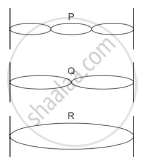Advertisements
Advertisements
प्रश्न
What do you understand by free vibrations of a body? Draw a displacement-time graph to represent them. Given one example.
उत्तर
The periodic vibrations of a body, of constant amplitude and constant frequency; are called free vibrations. The displacement-time graph to represent free vibrations of a body is given in the figure.
Example: A tuning fork vibrating in a vacuum.

APPEARS IN
संबंधित प्रश्न
The adjacent diagram shows three different modes of vibrations P, Q and R of the same string.

(i) Which vibration will produce a louder sound and why?
(ii) The sound of which string will have maximum shrillness?
(iii) State the ratio of wavelengths of P and R.
In following figure shows two tuning forks A and B of the same frequency mounted on two separate sound boxes with their open ends facing each other. The fork A is set into vibration.
- Describe your observation.
- State the principle illustrated by this experiment.

A vibrating tuning fork, held over an air column of a given length with its one end closed, produces a loud audible sound. Name the phenomenon responsible for it and explain the observation.
Why are the stringed instruments like guitar provided with a hollow sound box?
A tuning fork of frequency 256 Hz will resonate with another tuning fork of frequency:
In fig. , P, Q, R and S represent test tubes each of height 20 cm which are filled with water upto heights of 10 cm, 14 cm, 16 cm and 18 cm respectively. If a vibrating tuning fork is placed over the mouth of test tube Q, a loud sound is heard.
(i) Describe the observations with the tubes P, R and S.
(ii) Give the reason for your observation in each case.
(iii) State the principle illustrated by the above experiment.

On keeping the stem of a vibrating tuning fork on the surface of a table, a loud sound is heard. Give reason.
Explain a person walking past a railway line, in the middle of night hears a ringing sound along with the sound of his footsteps.
What are the factors that affect the frequency of a vibrating string and how do they affect the frequency?
